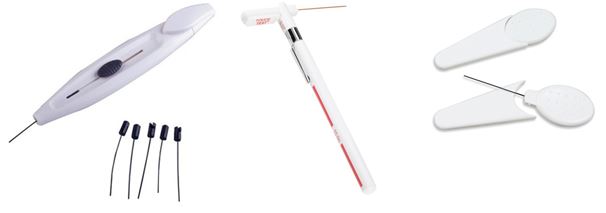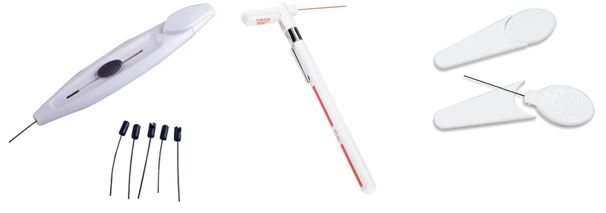AESTHESIOMETER, monofilament, 10 g, size 5.07
Valid Article
AESTHESIOMETER, monofilament
Definition
A manual stimulator designed to determine tactile sensation by patient response to the manual application of a thin filament to the skin. It typically consists of a filament with a pre-set flexibility and is intended to apply a known pressure upon application; the filament is attached to an appropriate handle/base that may also be intended to be loaded into a dedicated pen/holder. The device is used during diagnosis or treatment of nerve injuries and neuropathies associated with e.g., diabetes mellitus or leprosy. This is a reusable device.
Synonym
Semmes-Weinstein monofilament, diabetic monofilament
Specifications
Each filament will exert a specific, repeatable, force on the test site. The force exerted against the skin is a function of the length and diameter of the filament. This force remains constant, regardless the bend of the filament.
Technical specifications
- Point aesthesiometer with one monofilament.
- The monofilament is mounted on a holder and has a protection mechanism (retractable, folding into the holder or protective sheath) if not in use.
- The monofilament can be replaced if needed (spare part, brand specific)
- Monofilament is calibrated at 10 g = size 5.07
- Monofilament material : nylon
Supplied with the Article
Spare monofilament
Instructions for use
- Show the filament to the patient and touch it to his/her hand or arm so that he/she knows it does not hurt.
- Use the 10 gram filament to test sensation at the indicated sites on each foot.
- Hold the filament perpendicular to the skin and use a smooth motion when testing. Touch the skin until the filament bends in a letter ‘C' shape and then lift from the skin.
- Ask the patient to close the eyes and say “yes” when the filament is felt.
- Do NOT test directly on an ulcer, callus, scar or necrotic tissue, or very hard skin where sensation will be reduced
- Do not use rapid movement. The approach, skin contact, and departure of the filament should be approximately 1.5 seconds in duration.
- If the patient does not respond when you touch a given point on the foot, continue on another site.
For diabetes patients, lack of feeling at 4 or more out of 10 sites indicates a neuropathy.
Precautions for Use
The same monofilament should not be used for more than 10 patients in 24 hours because of fatigue of the monofilament nylon fibres and a less accurate result.
Maintenance
It is recommended to disinfect the article after each use on a patient by using a non-alcoholic disinfectant.
Can be cleaned and disinfected with aa detergent/disinfectant solution for surfaces / non-invasive medical equipment. Prepare use-solution in concentration required. Always read the label and product information before use. Do not mix with other products. Make sure to wet the surfaces completely, use a wipe or towel, keep them wet for the whole exposure time.
MSF requirements
Neuropathy screening by monofilament is important for identifying a ‘high-risk diabetic foot' and chronic poor glycaemic control, and should be performed at least once a year per patient.




